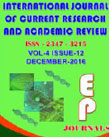Abstract Volume:4 Issue-12 Year-2016 Original Research Articles
 |
Online ISSN : 2347 - 3215 Issues : 12 per year Publisher : Excellent Publishers Email : editorijcret@gmail.com |
The present study was aimed at reducing the ammonia content in aquaculture systems using nitrifying bacteria (Nitrosomonas sp. and Nitrospira sp.) and a microalga (Chlorella vulgaris) by immobilization technique. Immobilization was performed in alginate beads. One set of beads was prepared by immobilizing nitrifying bacteria and another by immobilizing nitrifying bacteria-microalga consortium. Three tanks were set up and Zebra fish were added to each tank .Tank 1 and 2 served as test to which beads immobilized with bacteria were added. Tank 3 served as control. Similar set up was followed for beads immobilized with bacteria and alga. The beads were placed at the bottom to form an even bed. The set up was allowed to run for 4 days. pH, alkalinity, total hardness, chlorine, TDS, ammonia, nitrite, nitrate and total phosphorous were analysed daily for 4 days. Independent sample t-test was used to interpret the data statistically. The results suggested that there was a significant reduction in the parameters, ammonia and nitrite, between test and control. There was no significant difference between the values of parameters of experiments 1 and 2, i.e., test with immobilized bacteria and test with immobilized bacteria and alga. It was found that the trial carried out using immobilized bacteria with algae reduced the parameters such as hardness, alkalinity and TDS compared to trial carried out with beads immobilized with only bacteria. This technique can be used in various aquaculture systems to reduce the problem of increasing ammonia content in the waters thereby reducing the death of fish due to ammonia toxicity.
How to cite this article:
Nithiya, A., Polur Hanumantha Rao and Sathish Kumar, T. 2016. Bioremediation of Aquaculture Water using Nitrifying Bacteria-Microalga Consortium with Special Reference to Ammoniacal Nitrogen.Int.J.Curr.Res.Aca.Rev. 4(12): 164-177doi: http://dx.doi.org/10.20546/ijcrar.2016.412.016



Quick Navigation
- Print Article
- Full Text PDF
- How to Cite this Article
- on Google
- on Google Scholor
- Citation Alert By Google Scholar
